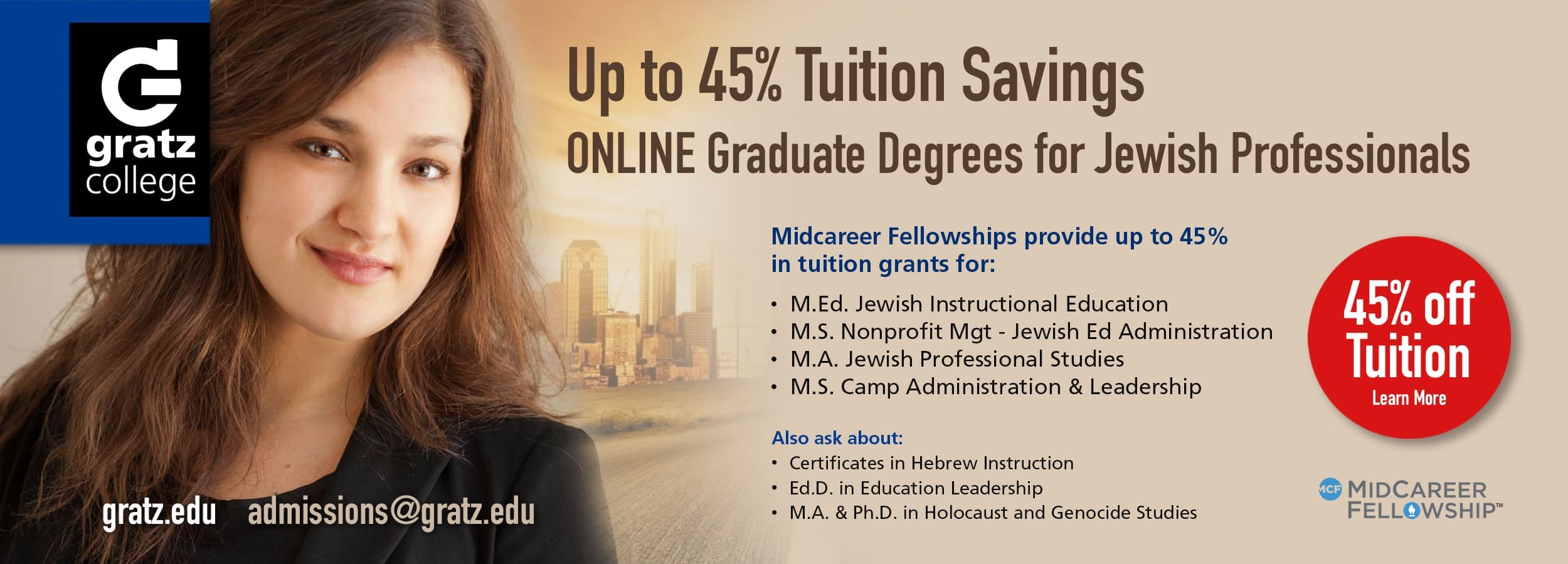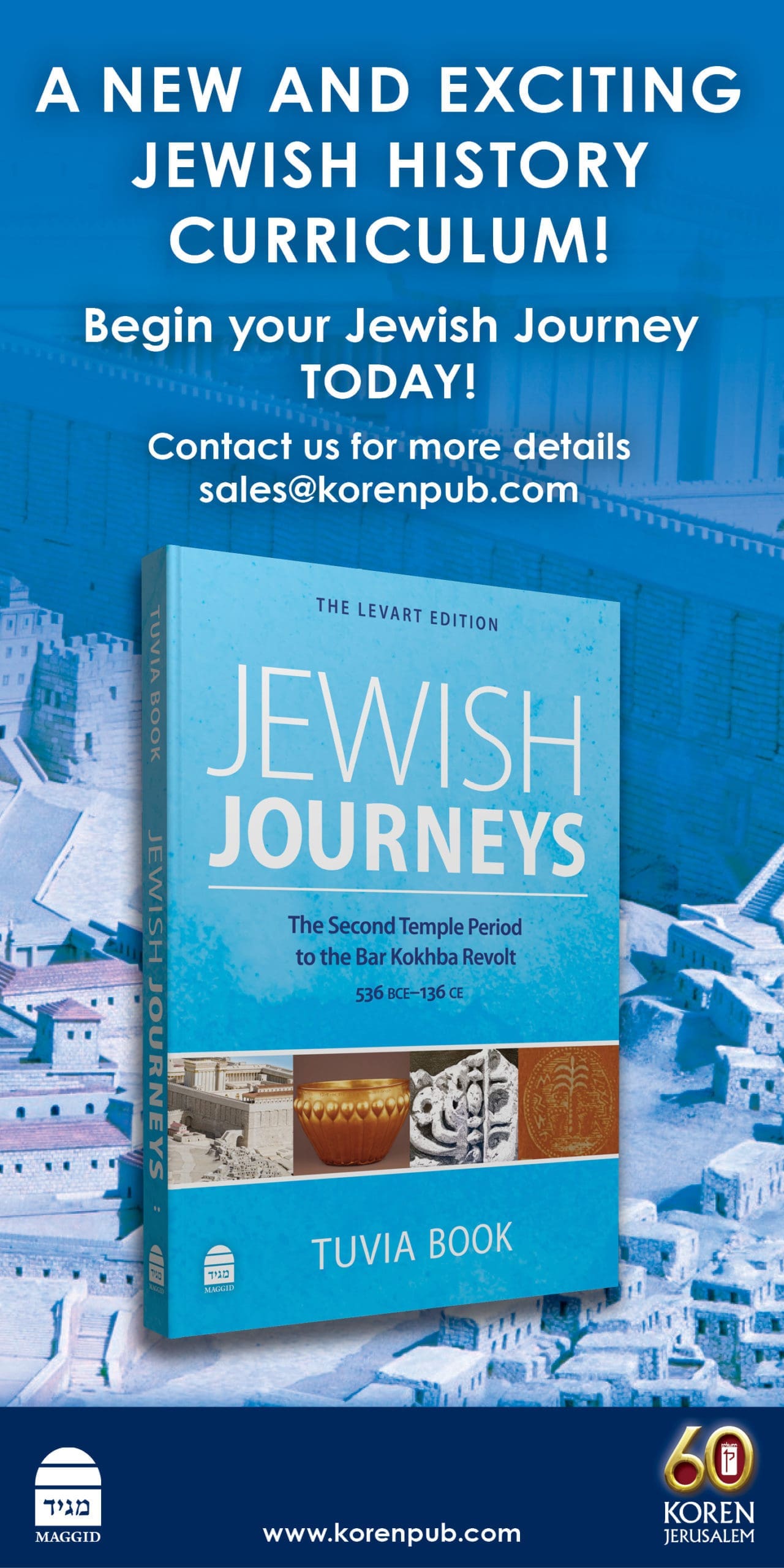The study of Jewish History builds Jewish pride, purpose, and belonging in students. Exploration of our 4,000-year past helps students develop into confident and empowered Jews who live with faith and commitment in the modern world. In principle, many Jewish day school leaders would agree that Jewish History ought to have a primary place in Jewish day school education, but they often find no easy path to develop an appropriate Jewish History program. Textbooks are rare, experienced Jewish History teachers are hard to find, and the dearth of resources makes it impractical to train novice teachers.
I suggest a framework to help develop a set of flexible and adaptable resources that might enable Jewish History education to flourish in a wide range of Jewish day school settings.
A Variety of Needs
Consider a few Jewish day schools interested in offering Jewish History programs:
School A wishes to integrate Jewish History into its History curriculum by dedicating 4 history class periods per quarter to a related topic in Jewish History each year. 16 periods per year, 48 total class periods over 3 years
School B is thinking about offering a weekly Jewish History elective to its seniors. 36 total class periods
School C is interested in offering a pair of one semester, 4x per week, Jewish History electives to its juniors. 72 class periods per semester, 144 total class periods
School D is prepared to dedicate core scheduling time to Jewish History. Students would have the opportunity to study Jewish History 3x a week for 3 years of high school. 108 class periods annually, 324 total class periods over 3 years
The variability in approaches to Jewish History education across Jewish day schools introduces a unique challenge apart from the typical challenges associated with curriculum development in the humanities. Can a single set of resources meet the needs of the wide variety of ways in which Jewish day schools seek to teach Jewish History?
An Adaptable Model
A Jewish History curriculum built as a series of self-contained but linked modules would offer a combination of rigor and flexibility to address the wide range of needs of each of the schools above.
- The basic structure of a modular curriculum is a 4-class period mini-unit designed to stand on its own as a self-contained learning experience.
- Each mini-unit, in addition to standing on its own, is designed to stack together with 2-3 other linked “mini-units” to form a full unit. A full unit, including 4 linked “mini-units” and two additional class periods for review and assessment, would take up approximately 18 total class periods.
- Each full unit, in addition to standing on its own, is designed to be stacked alongside 3 other full units to comprise a course of Jewish History learning.
Using this modular curricular structure, School A can select among mini-units to find just the right 4 period mini-unit to complement its History curriculum each quarter. School B can choose 2 full units and spread them out over the course of a year in a weekly class. School C can build semester-long course electives out of sets of 4 linked units. And School D can offer a full 3-year trajectory comprising 8 Jewish History units per year, covering 24 full units of Jewish History over the course of students’ high school experience.
Class periods immerse students in a historical moment
So much for logistics. What about narrative, message, and meaning? What actually happens inside each of these units?
Like humanities education more broadly, Jewish History education thrives on student curiosity, student exploration, and student analysis. Best practices in history education immediately transfer to success in Jewish History education. Excellent units begin by exploring student curiosity and prior knowledge on the subject. Excellent units end with meaningful assessments designed to challenge students to engage creatively, personally, and rigorously with historical material.
The core of each unit is a set of fascinating class periods built around active student exploration and analysis of primary sources along with vibrant classroom discussion and debate. Teachers provide contextual framing for primary sources, while students engage directly with the sources, immersing in the historical moment and making sense of the past for themselves. Along with the development of reading skills and analytic and critical thinking skills, students develop a deep sense of personal connection and value for the Jewish past when they have the opportunity to dig into it themselves.
Mini-units explore episodes
4,000 years provides the Jewish people with plenty of stories. Given limited time and resources and the competition for attention which is central to any contemporary educational effort, the first priority is to grab students’ attention. Here is a basic rubric worth considering in evaluating which episodes of Jewish History to incorporate into mini-units.
- Excitement: Compelling episodes tend to be story-driven, to feature dynamic characters, and to contain elements of surprise.
- Relevance: Compelling episodes offer the potential for providing context for contemporary Jewish opportunities and challenges.
- Resources: Compelling episodes are loaded with primary sources that allow students to dive into the story themselves. And they are backed by secondary sources that provide plenty of background and context for teachers to be well-prepared.
Hundreds of episodes might fit the bill. Here are ten:
- The Hasmonean dynasty and the Jewish encounter with Greek culture and power
- Saadia Gaon and the ups & downs of the Jewish experience under early Islam
- Yehuda Halevi and the world of medieval Hebrew poetry
- Shabbetai Zvi and 17th century messianism
- Gluckel of Hameln and the world of women in the kehilla
- Rabbi Nachman of Breslov and the world of Hasidut in the late 18th century
- Moses Mendelssohn and the Haskala efforts to “modernize” the kehilla world
- Anya Yezierska and the early 20th century American Jewish immigrant experience
- Rav Kook and the Old Yishuv/New Yishuv tensions in the early 20th century
- Abba Kovner and Jewish resistance in the Holocaust
Full units develop themes
For the sake of illustration, consider one theoretical full unit: “Europe, America, Palestine” (1880-1920). This unit might be comprised of 3 mini-units:
- Go to Palestine: Disillusionment with both the traditional religious world and the promise of Enlightenment & Emancipation left a group of brilliant creative Jews seeking something new. They landed on Jewish nationalism.
Mini-units break down to 3-4 class periods. This mini-unit might include a class on the rise of modern Jew-hatred in “Enlightened” capitals of Europe in the late 1800s; a class on the rise of “practical Zionism” in Eastern Europe; and a class on the rise of “political Zionism” in Western Europe.
- Go to America: Prospective immigrants had certain assumptions about what America held in store for them. The America they found upon arrival was a more complicated place.
This mini-unit might include a class on the glorified depictions of America circulating among Eastern European Jews in the late 1800s; a class on the systems of mutual support and integration developed by Jewish immigrants in America at this time; and a class on the persistent antisemitism that American Jews continued to face in the first few decades of the 20th century.
- Stay Where You Are: Two opposing groups remained committed to Europe: Reform Jews who believed that “Berlin is Jerusalem,” and Orthodox Jews who felt the physical dangers they knew were outweighed by the spiritual dangers they didn’t.
This mini-unit might include a class on the refiguring of messianic thinking in progressive Jewish denominations in this period; a class on the positions of Orthodox leaders in Europe who discouraged their community members from joining both the nascent Zionist movement and the flood of American immigrants; and a couple of classes comparing the situations of Jews in communities in Iran, North Africa, and the Middle East in the early 20th century.
Major thematic questions to explore in this unit might include:
- Galut/Geula: How do Jews think about and experience diaspora/exile/galut on the one hand vs. homeland/redemption/geula on the other?
- Contingency: History can seem obvious in retrospect. What is gained by going beyond looking at the past with hindsight to instead consider the challenges of decision-making within a historical moment?
- Tradition/Modernity: What are the various ways in which individual Jews and Jewish communities balance and negotiate among “modern” and “traditional” sets of values and ways of life?
Courses enable big picture thinking
A full unit offers a great deal of stand-alone value. But students really begin to develop a sense of the scope of Jewish History—and the attendant ability to think both subtly and broadly about Jewish identity and community—when full units get stacked alongside each other to create courses. Consider a few options for building the “Europe, America, Palestine” unit above into a course:
- Stack the “Europe, America, Palestine” unit with a Hasidut unit, a Haskala unit, a Zionism Unit, and a Holocaust unit and you get a Modern Jewish History course.
- Stack the “Europe, America, Palestine” unit with a unit on Modern Antisemitism, a unit on Pre-War Europe, and a unit on Nazi Germany, and a World War II unit and you get a Holocaust course.
- Stack the “Europe, America, Palestine” unit with a unit on the Rise of Zionism, a unit on Building the State of Israel, a Religious Zionism unit, and a unit on the Arab-Israeli Conflict and you have a Zionism course.
Each of these courses opens up the space for creative exploration and discussion of big picture thematic thinking on the same kinds of questions brought up in the “Europe, America, Palestine” unit itself: What does it mean to live in galut vs. geula? What does it mean to be a modern Jew? How do we make sense of our lives and communities in the context of the web of our historical experiences?
Next Steps
I want to close by noting that this modular model for Jewish history education is not purely theoretical. As an educational consultant and as Jewish History Department Chair at YULA High School in Los Angeles, I have worked with teachers and administrators to develop and successfully implement a wide range of Jewish History offerings. All have been built out of this modular system, allowing a combination of rigor and flexibility that works within any given set of scheduling and resource limitations while enabling deep student engagement and meaningful learning and growth.
I believe Jewish History education is among the most powerful tools available to Jewish school leaders and teachers in our work of building resilient, robust, and dynamic Jewish identity and Jewish community, and I hope the ideas laid out in this proposal spur efforts to make excellent programs in Jewish History education more widely available in the Jewish day school world.

Menachem Hecht is Jewish History Department Chair and Director of Israel Education at YULA High School. Rabbi Dr. Hecht lives in Los Angeles, CA with his wife and children, and engages in consulting and woodworking in his spare time.
Reach 10,000 Jewish educational professionals. Advertise in the upcoming issue of Jewish Educational Leadership.







